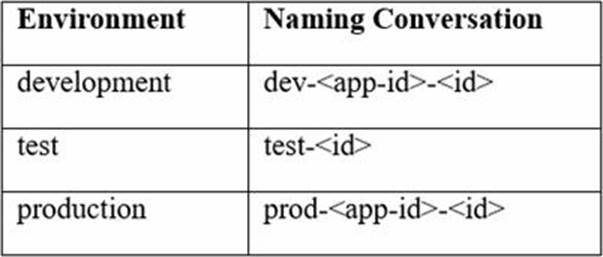VMware 2V0-31.20 Professional VMware vRealize Automation 8.1 Online Training
VMware 2V0-31.20 Online Training
The questions for 2V0-31.20 were last updated at Dec 19,2025.
- Exam Code: 2V0-31.20
- Exam Name: Professional VMware vRealize Automation 8.1
- Certification Provider: VMware
- Latest update: Dec 19,2025
The CTO releases a new company policy stating that all workloads need to be managed through vRealize Automation (vRA) so that access to day 2 operations can be controlled centrally through a policy. Prior to this policy, the App-Dev team deployed all of their 300 development and test workloads within a single public cloud vendor.
The naming convention used for workloads is provided in the following table:

The App-Dev team needs to onboard all of the running development workloads into vRA and allocate them to the App-Dev project. The administrator creates a new Onboarding
Plan and specifies the correct project and cloud account.
Which action should the administrator complete next to meet these requirements?
- A . Add 2 filtering rules, with Rule 1 criteria as “name:dev” and Rule 2 criteria as “status:on”.
- B . Add 1 filtering rule and combine the criteria “name:test” and “status:off”.
- C . Add 1 filtering rule and combine the criteria “name:dev” and “status:on”.
- D . Add 2 filtering rules, with Rule 1 criteria as “name:test” and Rule 2 criteria as “status:on”.
The administrator is tasked with creating a number of different content sources in Service Broker so that multiple types of catalog items can be created.
What is the only public cloud template that can be selected as a content source in Service Broker?
- A . Azure Resource Manager (ARM) templates
- B . AWS CloudFormation templates
- C . Alibaba Cloud Resource Orchestration Service templates
- D . Google Cloud Deployment Manager templates
Which kubectl command should be run to find the Kubernetes authentication method?
- A . kubectl describe pod <pod-name>
- B . kubectl describe secrets
- C . kubectl -n prelude describe pod <pod-name>
- D . kubectl explain
An IT Director wants to integrate existing Amazon Web Services CloudFormation templates into a new vRealize Automation deployment.
How can the administrator achieve this?
- A . Deploy a Cloud Proxy into the appropriate region of the pre-configured Amazon Web Services cloud account.
- B . Create and configure a custom integration into Cloud Assembly.
- C . Add content sources in Service Broker from the pre-configured Amazon Web Services cloud account.
- D . Leverage Action Based Extensibility (ABX) to extend functionality, programmatically.
An administrator is addressing a requirement to ensure that vRealize Automation evenly spreads the provisioned machines across hosts for a given region.
Where will the administrator configure this policy?
- A . Storage
- B . Volumes
- C . Cloud Zones
- D . Compute
Which type of tag can be used by an administrator from within a vRealize Automation blueprint to effect placement of provisioned items?
- A . Constraint tag
- B . Capability tag
- C . Standard tag
- D . Storage tag
While deploying a virtual machine blueprint, an administrator encounters the following error:
Error: com.vmware.xenon.common.LocalizableValidationException: Unable to find a valid subnet for network ‘Network_External’ of type ‘EXISTING’ with constraints ‘[dc:metro, tier:1]’, reasons: [Network profile ‘publicnet /Metro’ was skipped because [Network [Network_External] allocation: cannot allocate a network with static IP ranges for profile ‘publicnet /Metro’.]]
Where should the administrator start to troubleshoot?
- A . Cloud Zones
- B . Projects
- C . Network Profiles
- D . Tags
Which network profile uses network address translation (NAT) in vRealize Automation?
- A . Private network profile
- B . Existing network profile
- C . Outbound network profile
- D . Routed network profile
An administrator creates a content source to import three Cloud Assembly blueprints in to Service Broker. After some time, he is tasked with deleting the content source.
What would happen if and when this content source is deleted?
- A . All three blueprints are deleted from Service Broker and Cloud Assembly.
- B . Only the content source is deleted but the blueprints remain intact in Service Broker.
- C . All three blueprints are deleted from Service Broker.
- D . Once created, a content source cannot be deleted.
An administrator is setting up a storage profile for one of the public cloud accounts.
Which cloud account allows the configuration of device type “EBS” and volume type “General Purpose SSD”?
- A . VMware Cloud on AWS
- B . Google Cloud Platform
- C . Amazon Web Services
- D . Microsoft Azure
Latest 2V0-31.20 Dumps Valid Version with 87 Q&As
Latest And Valid Q&A | Instant Download | Once Fail, Full Refund

